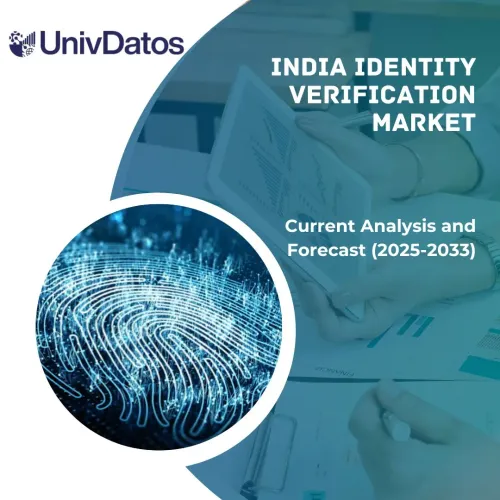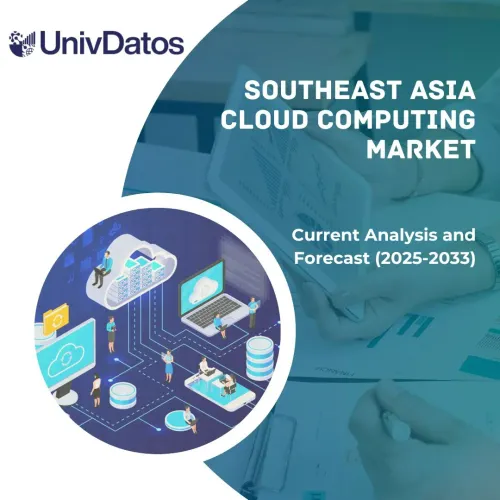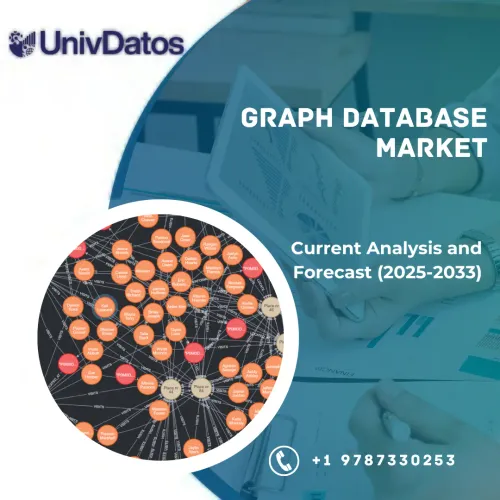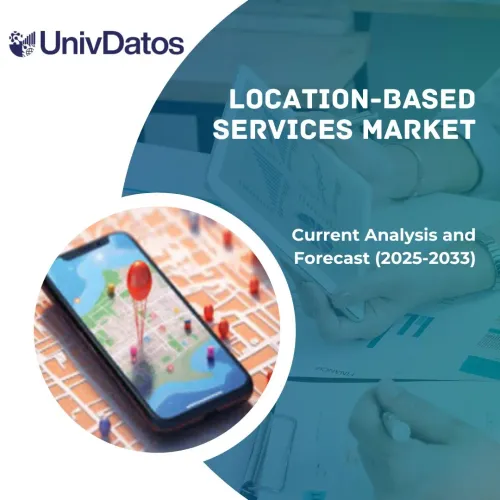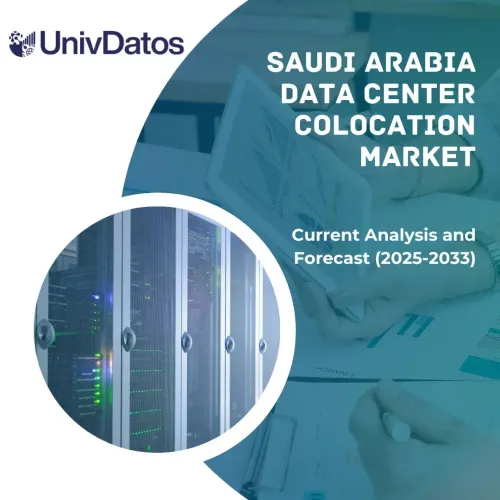- Home
- About Us
- Industry
- Services
- Reading
- Contact Us
Enterprise Quantum Computing Market: Current Analysis and Forecast (2024-2032)
Emphasis on Technology (Quantum Annealing, Superconducting, Trapped Ion, Quantum Dot, and Others), Application (Machine Learning/Deep Learning/AI, Optimization, Simulation & Data Modeling, Cyber Security, and Others), Region/Country.
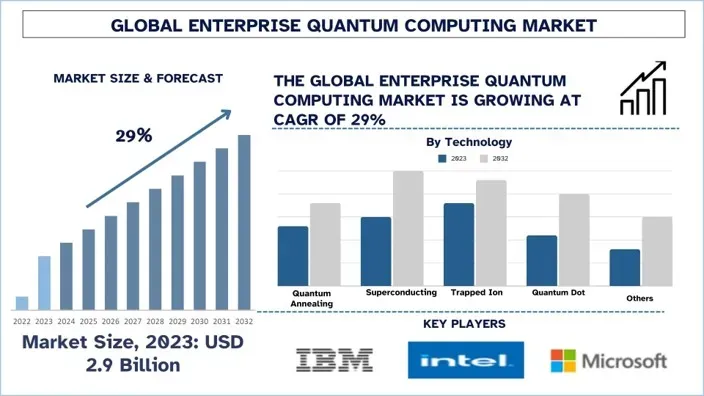
Enterprise Quantum Computing Market Size & Forecast
The enterprise quantum computing market holds a promising Potential for Exponential Speedup with a CAGR of 29% for the forecast period (2024-2032). Quantum computing can be beneficial as it increases the speed of computations of specific algorithms and problems exponentially many times and can be applied to optimization, cryptography, and the simulation of material properties. In addition, the quantum computing ecosystem of companies, research labs, and startups is increasingly offering enterprises better solutions and services.
Enterprise Quantum Computing Market Analysis
Enterprise quantum computing can be described as using quantum computing solutions in companies and institutions to address problems that regular computers cannot handle. Quantum computers, on the other hand, solve problems using principles of quantum mechanics. They use quantum bits, also known as qubits, simultaneously in multiple states. This enables the solution of specific problems at an enormously faster rate than classical computers.
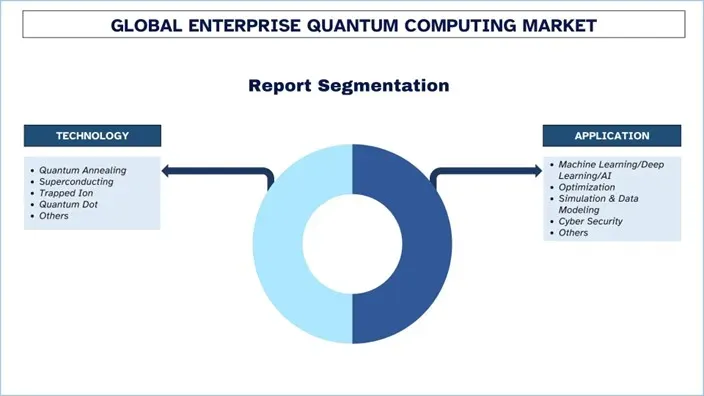
Enterprise Quantum Computing Market Trends
This section discusses the key market trends influencing the various segments of the Enterprise Quantum Computing market as identified by our research experts.
The Rise of Cloud-Based Quantum Computing in Enterprise Markets
One of the trends demonstrated in the enterprise quantum computing market is the growth of the cloud-based quantum computing services that allow businesses to use quantum processors not having to purchase the necessary equipment. Quantum computing is being adopted into the cloud services of industry-leading technology giants such as IBM, Amazon, and Microsoft to enable businesses to test quantum algorithms in various fields such as optimization, machine learning, and cryptography. It is denaturing and maturing through increased access that embodies collaboration, application, and even adaptation while still in the process of hardware enhancement as well as error calibration.
Enterprise Quantum Computing Industry Segmentation
This section provides an analysis of the key trends in each segment of the global Enterprise Quantum Computing market report, along with forecasts at the global, regional, and country levels for 2024-2032.
The superconducting technology market dominates the Enterprise Quantum Computing market.
The segments based on technology that constitute the enterprise quantum computing market include quantum annealing, superconducting, trapped ions, quantum dots, and others. The superconducting technology market emerged as the largest one in the market in 2023. Superconducting qubits have also been shown to be scalable, which means that it is possible for large-scale quantum computing to be built, and these would be capable of performing very complex calculations. Furthermore, major global players in quantum computing, including IBM, Google, and Rigetti Computing, have heavily promoted and researched superconducting qubit technology.
The optimization category dominates the Enterprise Quantum Computing market.
Based on the Application, the enterprise quantum computing market has been classified into Machine Learning/Deep Learning/AI, Optimization, Simulation & Data Modeling, Cyber Security, and Others. Out of all the segments discussed, the optimization segment dominated the market in 2023. Fields such as logistics, finance, manufacturing, and retail industries are among the beneficiaries of optimization algorithms that enhance the flow of operations and data utilization. Algorithms like Quantum Annealing, which are quantum algorithms, are meant to find the global minimum of specific objective functions; quantum algorithms are significantly superior to classical strategies.
North America held a dominant share of the enterprise quantum computing market in 2023
In 2023, the market was led by North America, which accounts for the largest market share. The United States government, through NASA, DOE, and DARPA, among others, sponsors research and development of quantum technology, offering a favorable environment for quantum technology. Moreover, North American companies are already implementing quantum computing in finance, healthcare, aerospace, cybersecurity, and other fields, which are physical examples of the market applicability of this technology.
The U.S. held a dominant share of the North American enterprise quantum computing market in 2023
The market size of Quantum computing has grown significantly in the United States due to the joining of tech giants like IBM, Google, & Microsoft, and the various sectors, especially the financial, health, and cybersecurity sectors, require better computing solutions. With recent developments in quantum hardware and software, quantum computing is gradually being applied in various functional areas that involve optimization issues and the acceleration of artificial intelligence. Government policies and grants add to this increment, further enhancing the growth of quantum technology in the United States. Thus, difficulties such as error correction, solution scalability, and talent deficit are still major barriers to implementing the solution in enterprises.
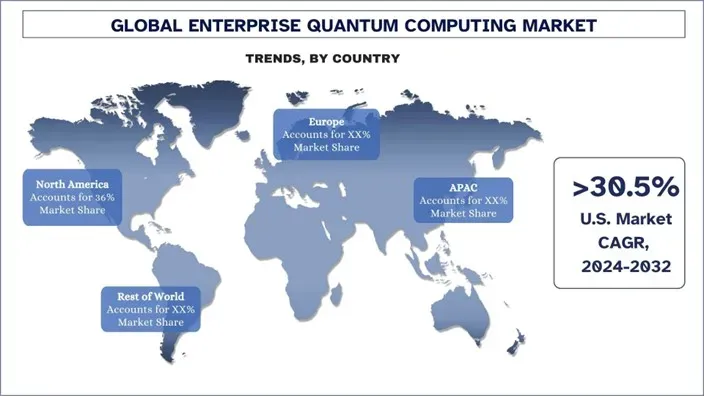
Enterprise Quantum Computing Industry Overview
The Enterprise Quantum Computing Market is competitive and fragmented, with several global and international market players. The key players are adopting different growth strategies to enhance their market presence, such as partnerships, agreements, collaborations, new product launches, geographical expansions, and mergers and acquisitions. The major players operating in the market are Alibaba Group, D-Wave Systems Inc., Google LLC, Huawei Technologies Co., Ltd., International Business Management Corporation (IBM), ID Quantique (SK Telecom), Intel Corporation, Microsoft Corporation, Rigetti & Co, Inc., and Toshiba Corporation.
Enterprise Quantum Computing Market News
Currently, Alphabet is planning to invest $1 billion in the construction of a new Quantum AI campus in Santa Barbara, California. This is a commitment towards developing quantum computing, research, and commercialization since this facility will house all of Google’s quantum computing activities.
Microsoft is also progressing with its Azure Quantum, a quantum computing system that adapts quantum hardware and software. In the recent past, Microsoft has worked with ColdQuanta to incorporate ultracold atoms in building quantum computers and broaden the variety of quantum applications on the Azure Quantum.
Some existing companies, such as Rigetti Computing and D-Wave Systems, have been working on enhancing the efficiency and capacity of quantum processors. Rigetti released a 32-qubit quantum processor, while D-Wave made over 5000 qubit quantum systems, known as Advantage quantum systems, available for use.
Enterprise Quantum Computing Market Report Coverage
Report Attribute | Details |
Base year | 2023 |
Forecast period | 2024-2032 |
Growth momentum | Accelerate at a CAGR of 29% |
Market size 2023 | USD 2.9 Billion |
Regional analysis | North America, Europe, APAC, Rest of the World |
Major contributing region | Asia-Pacific is expected to grow at the highest CAGR during the forecasted period. |
Key countries covered | U.S., Canada, Germany, United Kingdom, Spain, Italy, France, China, Japan, and India |
Companies profiled | Alibaba Group, D-Wave Systems Inc., Google LLC, Huawei Technologies Co., Ltd., International Business Management Corporation (IBM), ID Quantique (SK Telecom), Intel Corporation, Microsoft Corporation, Rigetti & Co, Inc., and Toshiba Corporation. |
Report Scope | Market Trends, Drivers, and Restraints; Revenue Estimation and Forecast; Segmentation Analysis; Demand and Supply Side Analysis; Competitive Landscape; Company Profiling |
Segments Covered | By Technology; By Application; By Region/Country |
Reasons to buy Enterprise Quantum Computing Market report:
The study includes market sizing and forecasting analysis validated by authenticated key industry experts.
The report briefly reviews overall industry performance at a glance.
The report covers an in-depth analysis of prominent industry peers, primarily focusing on key business financials, product portfolios, expansion strategies, and recent developments.
Detailed examination of drivers, restraints, key trends, and opportunities prevailing in the industry.
The study comprehensively covers the market across different segments.
Deep dive regional-level analysis of the industry.
Customization Options:
The Global enterprise quantum computing Market can be customized by requirement or any other market segment. Besides this, UnivDatos understands that you may have your own business needs; hence, feel free to contact us to get a report that completely suits your requirements.
Table of Content
Research Methodology for the Enterprise Quantum Computing Market Analysis (2024-2032)
We analyzed the historical market, estimated the current market, and forecasted the future market of the global Enterprise Quantum Computing market to assess its application in major regions worldwide. We conducted exhaustive secondary research to gather historical market data and estimate the current market size. To validate these insights, we carefully reviewed numerous findings and assumptions. Additionally, we conducted in-depth primary interviews with industry experts across the Enterprise Quantum Computing value chain. After validating market figures through these interviews, we used both top-down and bottom-up approaches to forecast the overall market size. We then employed market breakdown and data triangulation methods to estimate and analyze the market size of industry segments and subsegments:
Market Engineering
We employed the data triangulation technique to finalize the overall market estimation and derive precise statistical numbers for each segment and sub-segment of the global Enterprise Quantum Computing market. We split the data into several segments and sub-segments by analyzing various parameters and trends, including product type, material type, packaging type, distribution channel, and regions within the global Enterprise Quantum Computing market.
The main objective of the Global Enterprise Quantum Computing Market Study
The study identifies current and future trends in the global Enterprise Quantum Computing market, providing strategic insights for investors. It highlights regional market attractiveness, enabling industry participants to tap into untapped markets and gain a first-mover advantage. Other quantitative goals of the studies include:
Market Size Analysis: Assess the current and forecast market size of the global Enterprise Quantum Computing market and its segments in terms of value (USD).
Enterprise Quantum Computing Market Segmentation: Segments in the study include areas of technology, application, and regions.
Regulatory Framework & Value Chain Analysis: Examine the regulatory framework, value chain, customer behavior, and competitive landscape of the enterprise quantum computing industry.
Regional Analysis: Conduct detailed regional analysis for key areas such as Asia Pacific, Europe, North America, and the Rest of the World.
Company Profiles & Growth Strategies: Company profiles of the Enterprise Quantum Computing market and the growth strategies adopted by the market players to sustain in the fast-growing market.
Frequently Asked Questions FAQs
Q1: What is the enterprise quantum computing market's current size and growth potential?
The enterprise quantum computing market was valued at USD 2.9 billion in 2023 and is expected to grow at a CAGR of 29% during the forecast period (2024-2032).
Q2: Which segment has the largest share of the enterprise quantum computing market by technology?
The superconducting segment led the market in 2023. Superconducting qubits have demonstrated scalability, allowing for the potential development of large-scale quantum computing systems capable of performing complex computations. Also, Leading companies in quantum computing, such as IBM, Google, and Rigetti Computing, have invested significantly in superconducting qubit technology, driving advancements and commercialization efforts.
Q3: What are the driving factors for the growth of the enterprise quantum computing market?
Exponentially Faster Computations: Quantum computers can significantly speed up tasks in optimization, cryptography, and material science.
Expanding Ecosystem: More companies, startups, and research labs are working on quantum hardware, software, and applications, making solutions more accessible to enterprises.
Strategic Investments: Ongoing funding from governments and venture capital firms fuels technological advances and market traction.
Q4: What are the emerging technologies and trends in the enterprise quantum computing market?
Hybrid Quantum-Classical Computing: Integrating quantum and classical systems to enhance performance and reduce errors.
Quantum-as-a-Service (QaaS): Cloud-based platforms offer quantum computing resources on demand.
Error Correction & Fault Tolerance: Ongoing research aimed at building more reliable quantum systems.
Q5: What are the key challenges in the enterprise quantum computing market?
Technical Limitations & Scalability: Quantum computers require extremely precise conditions (e.g., ultra-cold temperatures), making them costly and difficult to scale.
Skill Gaps: Specialized knowledge is needed to develop quantum algorithms and maintain quantum hardware.
Long Development Timelines: Quantum research is still evolving, and breakthroughs can be slow to translate into fully commercial solutions.
Q6: Which region will dominate the enterprise quantum computing Market?
North America is projected to maintain its leadership throughout the forecast period due to the region’s strong R&D ecosystem, abundant funding, and concentration of major tech companies help drive rapid advancements in quantum computing technology.
Q7: Who are the key competitors in the enterprise quantum computing market?
- Alibaba Group
- D-Wave Systems Inc.
- Google LLC
- Huawei Technologies
- IBM
- ID Quantique (SK Telecom)
- Intel Corporation
- Microsoft Corporation
- Rigetti & Co., Inc.
- Toshiba Corporation
Q8: What are the key investment opportunities in the enterprise quantum computing market?
Quantum Hardware Startups: Funding R&D that pushes quantum processing speeds and stability.
Quantum Software Solutions: Developing specialized algorithms and applications for enterprise use.
Cloud-Based Quantum Services: Offering on-demand quantum computing resources without the need for in-house infrastructure.
Strategic Partnerships: Collaborating with tech giants and academic institutions to stay ahead of technological breakthroughs.
Q9: How can enterprises prepare for the adoption of quantum computing?
Upskill Teams: Provide training in quantum computing principles and potential applications.
Evaluate Hybrid Solutions: Explore quantum-classical architectures to gradually integrate quantum capabilities.
Collaborate & Pilot: Partner with quantum technology providers, join research consortia, and run pilot programs to stay at the forefront of innovation.
Monitor Regulations: Stay informed on global security standards and compliance requirements for quantum technologies.
Related Reports
Customers who bought this item also bought




